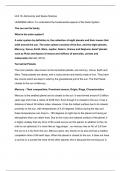Essay
Unit 16 - Learning Aim A Distinction Achieved
- Institution
- PEARSON (PEARSON)
Distinction achieved. Describes: • Planets - Composition, Rings, Characteristics, Origin • Solar system • Gaseous ans Terrestrial Planets • Sun compostion • Kuiper belt, Van Allen radiation, Forces applied
[Show more]



